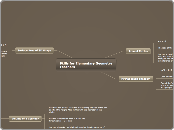Skills for Elementary Geometry Teachers
Area of Circles
A= πr^2
The ratio of the circumference of a cicle to its diameter, 2πr
You can show this by cutting the circle in half, into another half, and over and over until you get a rectangular row of triangles left. The two bases of this rectangle equal the cirumference of the circle.
Pythagorean Theorem
A^2 + B^2 = C^2
Used to find the side and base length of triangles.
One of the 'nice' triangles is where A = 4 and B = 3. Plugging in the equation 4^2 + 3^2 = C^2. When you add 4^2 and 3^2 you get 25. The square root of 25 solves to find C = 5.
Surface Area of 3D Shape
SA = 2B + PH
B is the area of the base. This is found when you multiply the sides of the base together. You multiply B by 2 because there are 2 bases. P is the perimeter of the base. H is the height.
Applications
Volume of a Cylinder
Use base ten blocks. Place the blcoks along the side of the can and find the height. Also do this with the diameter of the circle.
Use the formulas for Area = π r^2 and Circumfrence = 2 x π x r
You can also take the label and see that the circumfrence of the circular base is also the length of the side.
Symmetrical 3D Shapes
Area of the base can lead you to the area of the entire shape. This onyl works with cylinders and prisms.
Volume = base x height
